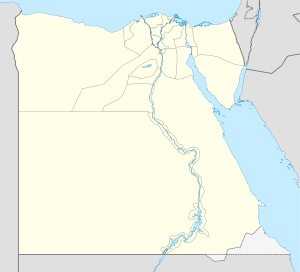- Nag Hammadi
-
This article is about the Egyptian settlement. For the cache of Gnostic texts discovered nearby, see Nag Hammadi library.
Nag Hammadi Location in Egypt Coordinates: 26°03′N 32°15′E / 26.05°N 32.25°E Country  Egypt
EgyptGovernorate Qena Governorate Time zone EST (UTC+2) Nag Hammadi (Arabic: نجع حمادى, IPA: [ˈnæɡʕe ħæmˈmæːdi]), is a city in Upper Egypt. Nag Hammadi was known as Chenoboskion (Greek: Χηνοβόσκιον) in classical antiquity, meaning "geese grazing grounds". It is located on the west bank of the Nile in the Qena Governorate, about 80 kilometres north-west of Luxor.
It has a population of about 30,000, who are mostly farmers. Sugar and aluminium are produced in Nag Hammadi.
The town of Nag Hammadi was established by Mahmoud Pasha Hammadi, who was a member of the Hammadi family in Sohag, Egypt. Mahmoud Pasha Hammadi was a major landholder in Sohag, and known for his strong opposition to the British occupation.
Mahmoud Pasha Hammadi created Nag Hammadi for the indigenous people from Sohag who were forced to abandon their homeland by the British occupation. In recognition of this, the new town was given the name "Hammadi".[citation needed]
The Nag Hammadi Library
Nag Hammadi is best known for being the site where local farmers found a sealed earthenware jar containing thirteen leather-bound papyrus codices, together with pages torn from another book, in December 1945. The mother of the farmers burned one of the books and parts of a second (including its cover). Thus twelve of these books (one missing its cover) and the loose pages survive.[1] The writings in these codices, dating back to the 2nd century AD,[2] comprised 52 mostly Gnostic tractates (treatises), believed to be a library hidden by monks from the nearby monastery of St Pachomius when the possession of such banned writings, denounced as heresy, was made an offence.[citation needed]
The contents of the Coptic-bound codices were written in Coptic, though the works were probably all translations from Greek. Most famous of these works must be the Gospel of Thomas, of which the Nag Hammadi codices contain the only complete copy.
All the texts have been public since 1975, and are available online.
Nag Hammadi massacre
The city was the site of the Nag Hammadi massacre in January 2010, wherein eight Coptic Christians were shot dead by three Muslim men.[3] Nineteen Coptic Christians were attacked altogether.[3][4][5]
Notes
- ^ James M. Robinson (1988). The Nag Hammadi Library. San Francisco: Harper San Francisco.. "The Nag Hammadi library consists of twelve books, plus eight leaves removed from a thirteenth book in late antiquity and tucked inside the front cover of the sixth. These eight leaves comprise a complete text, an independent treatise taken out of a book of collected essays." (p.10)
- ^ www.nag-hammadi.com
- ^ a b Egypt's anxious Copts 'await next catastrophe'
- ^ http://translate.google.com/translate?js=y&prev=_t&hl=en&ie=UTF-8&layout=1&eotf=1&u=http%3A%2F%2Fwww.elfagr.org%2FNewsDetails.aspx%3FnwsId%3D15807%26secid%3D3611&sl=ar&tl=en
- ^ "Egypt church attack kills Copts". BBC News. 2010-01-07. http://news.bbc.co.uk/2/hi/middle_east/8444851.stm.
Categories:- Qena Governorate
- Populated places in Egypt
Wikimedia Foundation. 2010.

